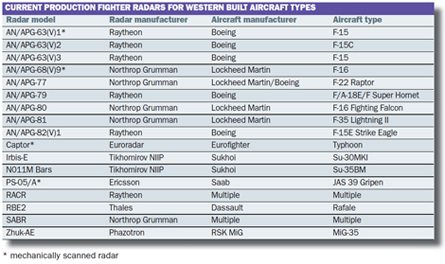Extract from the Fighter Radars Special Report 2010 now available for FREE
Avionics equipment typically accounts for around one-third of the total purchase cost of a new fighter, and with budget pressures currently being felt more acutely than ever by many, buyers are demanding greater capability, improved reliability and reduced operating costs from such systems.
In the fighter radar business area, the recent rise of active electronically scanned array (AESA) technology offers the potential to satisfy such demands. Comprising hundreds of transmit/receive (T/R) modules, each acting like individual radars, the AESA holds the promise of delivering improved performance, but with minimum maintenance demands. Such sensors could last for the entire service life of a fighter, with the small percentage of individual modules that will fail over this time to have no or little effect on overall system performance: a trait referred to as “graceful degradation”.
Crucially, industry officials now believe that AESA technology has reached a point where systems can cost the same to manufacture as a mechanically-scanned array; the benchmark for fighter radar design for the last several decades. Perhaps more importantly than their support benefits, active, or ‘E-scan’ arrays also offer operational advantages, by delivering increased detection range and more agile beam-forming, which reduces the risk of a host platform being identified when using its primary sensor. Once combined with new-generation beyond visual-range air-to-air missiles, an AESA system could be a true battle winner, by delivering a vital “look first, shoot first” capability.
But with air-to-air engagements having become extremely rare in today’s operational environment, further advantages must be offered. Ground mapping is already possible using an AESA, and emerging developments could also see such devices used for applications such as jamming other radars and performing electronic attacks. Such multifunction capability has a clear attraction for cash-strapped air forces looking to get the most out of their small fleets of combat aircraft. Accordingly, E-scan systems have swiftly moved from being an expensive market fad to a must-have item for fighter manufacturers keen to secure hard-fought orders on the global stage.
 | Flightglobal Insight's Fighter Radars Special Report 2010 is brought to you in association with Raytheon and provides an overview on the fighter radar market. The report focuses on products currently available or being developed by Western and Russian manufacturers. Download the Fighter Radars Special Report for FREE. |
|---|
Visit Flightglobal Insight to view our full collection of FREE analytical reports
Source: FlightGlobal.com























